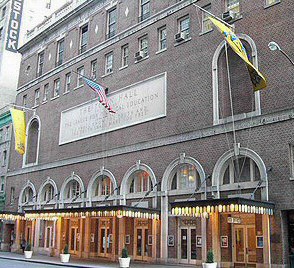

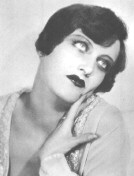
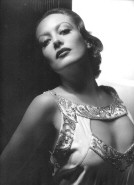




The Best ofT
Taplinger, Bob. Director of publicity at Warner's in the '40s.
 Tashman,
Lilyan. (10/23/1899 - 3/21/34) Brooklyn-born actress on whom photographer Cecil
Beaton claimed Joan had a crush: "At one time she was insatiably interested
in Miss Dietrich...Then she moved on to Lilyan Tashman, followed by the chief
of her idols--Greta Garbo." (DF) Tashman's
film career lasted from 1921 to her 1934 death after cancer surgery; she
appeared in Joan's 1925 film Pretty Ladies.
Tashman,
Lilyan. (10/23/1899 - 3/21/34) Brooklyn-born actress on whom photographer Cecil
Beaton claimed Joan had a crush: "At one time she was insatiably interested
in Miss Dietrich...Then she moved on to Lilyan Tashman, followed by the chief
of her idols--Greta Garbo." (DF) Tashman's
film career lasted from 1921 to her 1934 death after cancer surgery; she
appeared in Joan's 1925 film Pretty Ladies.
 Taylor,
Elizabeth. (2/27/32 - 3/23/11) Taylor made her film debut for Universal
in 1942 and the next year was signed to MGM, whose 1944 National Velvet
made her a star. By 1953, when she and Joan met while Joan was filming Torch
Song
with Liz-Husband Number 2 Michael
Wilding,
Taylor had graduated to adult roles, having appeared in 1950's Father of
the Bride and 1951's much darker A Place in the Sun.
Taylor,
Elizabeth. (2/27/32 - 3/23/11) Taylor made her film debut for Universal
in 1942 and the next year was signed to MGM, whose 1944 National Velvet
made her a star. By 1953, when she and Joan met while Joan was filming Torch
Song
with Liz-Husband Number 2 Michael
Wilding,
Taylor had graduated to adult roles, having appeared in 1950's Father of
the Bride and 1951's much darker A Place in the Sun.
Apparently all was not calm between the two during the filming of Torch: A frequent visitor to the set, Liz snubbed Joan one day by not saying "hello"; Joan then accosted publicity man Dore Freeman and said "You tell that little bitch never to walk in here without acknowledging me. I want you to teach her some manners." (LW) Joan also allegedly suggested to Wilding that he put a harness on his wife. Liz later told reporters that her husband was very fortunate to be playing a blind man in his first American film: "That way he doesn't have to look at Joan Crawford throughout the entire movie." (DF)
Taylor, Robert. (8/5/11 - 6/8/69) IMDb info. Wikipedia entry.
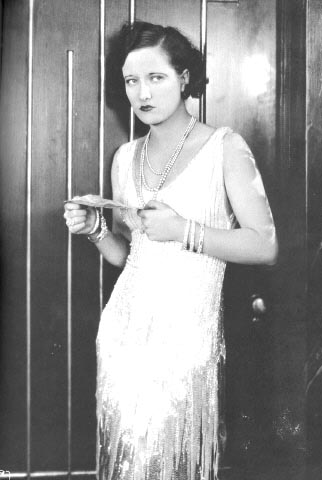 Taxi
Dancer, The. MGM silent, 1927. Directed by Harry Millarde, 64 minutes. Joan gets top billing for the first time here
as "Joselyn Poe," a Southern Belle chasing her dancing dream in
New York. Says Joan in CWJC: My
only fond memories of Taxi Dancer is the fact that I was better
than the picture. It was the first time I dared do a part my way, the hell with
the director's ideas, and it worked.
Taxi
Dancer, The. MGM silent, 1927. Directed by Harry Millarde, 64 minutes. Joan gets top billing for the first time here
as "Joselyn Poe," a Southern Belle chasing her dancing dream in
New York. Says Joan in CWJC: My
only fond memories of Taxi Dancer is the fact that I was better
than the picture. It was the first time I dared do a part my way, the hell with
the director's ideas, and it worked.
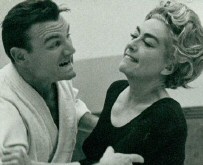 Tegner,
Bruce (1929 - 1985). Martial artist who instructed Joan for
her jujitsu scenes in 1963's The
Caretakers. (He also choreographed Sinatra's fight scene
in The Manchurian Candidate.) He operated a martial arts
studio in Hollywood between 1952 and 1967, and published dozens
of influential books on the subject.
Tegner,
Bruce (1929 - 1985). Martial artist who instructed Joan for
her jujitsu scenes in 1963's The
Caretakers. (He also choreographed Sinatra's fight scene
in The Manchurian Candidate.) He operated a martial arts
studio in Hollywood between 1952 and 1967, and published dozens
of influential books on the subject.
USAdojo.com site. Fullwiki.org page. Find-a-Grave memorial. Amazon books by Tegner.
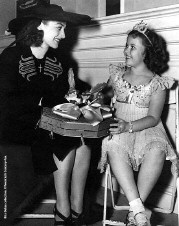 Temple,
Shirley
(4/23/28 - 2/10/14). In her book, Child
Star, Shirley Temple Black recounts how she failed an audition for the role
of Joan's character as a child in 1933's Dancing Lady. Later, a mutual friend, George Murphy, brought Joan to
meet Temple on the set of Little Miss Broadway. Joan offered her a box of Austrian chocolates saying, "Do you
like candy or do they make you fat?"
Temple,
Shirley
(4/23/28 - 2/10/14). In her book, Child
Star, Shirley Temple Black recounts how she failed an audition for the role
of Joan's character as a child in 1933's Dancing Lady. Later, a mutual friend, George Murphy, brought Joan to
meet Temple on the set of Little Miss Broadway. Joan offered her a box of Austrian chocolates saying, "Do you
like candy or do they make you fat?"
Temple describes Joan as: ...impeccably groomed and acutely self-conscious about
every fold in her skirt. Her elbow length black gloves were constantly being
adjusted so as to be absolutely even, and her mannish suit of jet black
elegantly framed the large golden cross at her bosom. Altogether, she was a
beautiful and incandescent person, picture-postcard perfect.
Temple later met Joan with adopted children Christina and Christopher and then-husband Phillip Terry. Temple describes the children as having "...performed like a programmed wind-up toy." Christina peeked into her closet and remarked about the amount of clothes inside; Temple said they were costumes. While Joan was examining Temple's mother's glass miniatures, Christopher punched Joan hard on the thigh, which prompted Joan to slap him on the cheek, sending him into a fit that gained everyone's attention. Finally, Temple recalls a gift that Joan gave her, a cocker spaniel puppy that died the very next day before she could name it.
Wikipedia page. IMDb page. Official website.
 Terry, Phillip. (3/7/09
- 3/23/93) Actor,
Joan's third husband. Born Frederick Kormann, Terry worked on oil rigs as a
young man and played football for Stanford, later studying drama in London. He
debuted on film as an MGM contract player in 1937; perhaps his most prestigious
role was as Ray Milland's brother in 1945's The Lost Weekend.
Overall he made more than 60 films (the last in '72) and numerous TV appearances
in the '50s and '60s. Despite his dashing looks, various sources report
him as being rather "bovine" and that the marriage seemed "mechanical,"
even to the point where the couple had sex according to a schedule. Says Joan in CWJC of their marriage: A
mutual mistake. He was and is a very nice man, but we weren't made for each
other.
Terry, Phillip. (3/7/09
- 3/23/93) Actor,
Joan's third husband. Born Frederick Kormann, Terry worked on oil rigs as a
young man and played football for Stanford, later studying drama in London. He
debuted on film as an MGM contract player in 1937; perhaps his most prestigious
role was as Ray Milland's brother in 1945's The Lost Weekend.
Overall he made more than 60 films (the last in '72) and numerous TV appearances
in the '50s and '60s. Despite his dashing looks, various sources report
him as being rather "bovine" and that the marriage seemed "mechanical,"
even to the point where the couple had sex according to a schedule. Says Joan in CWJC of their marriage: A
mutual mistake. He was and is a very nice man, but we weren't made for each
other.
See also Husbands of Joan. IMDb info.
Thalberg, Irving. (5/30/1899 - 9/14/1936) IMDb info. Wikipedia entry.
Theatre 80. Originally a speakeasy (Scheib's Place) during Prohibition, this East Village landmark at 80 St. Marks later became a jazz hotspot (Jazz Gallery) and then a revival cinema (Theatre 80) in August 1971. Joan, in 1971, was one of the first of dozens of film and theater legends to place hand-prints on its sidewalk. (In 1994, the site became home to the Pearl Theatre Company; in 2009, it again became known as "Theatre 80.")
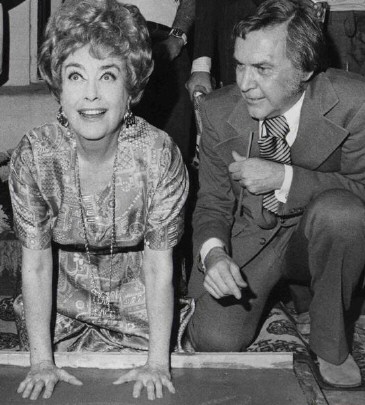
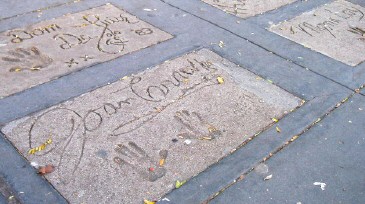

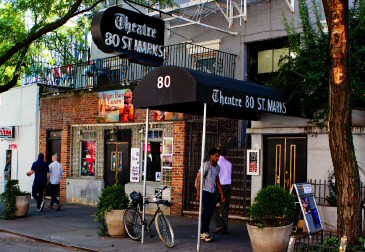
Photos of Joan at St. Marks (this site)
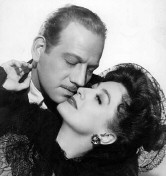 They
All Kissed the Bride. Columbia, 1942. Directed by Alexander Hall, 86 minutes.
Carole Lombard was originally to star in this film; when she was killed in a
plane crash, Joan took over her role, donating the $112,500 salary to the Red
Cross. (LY)
Joan stars as hard
businesswoman "Margaret Drew," who's eventually softened up by the
advances of Melvyn Douglas. Says Joan in CWJC: ...my
first picture away from Metro, and I felt as though I were in another country.
But Melvyn was on hand, and so was a very fine script, so it came
off quite well. The title was silly, but the picture had a nice flair, and it
came off better than anyone expected.
They
All Kissed the Bride. Columbia, 1942. Directed by Alexander Hall, 86 minutes.
Carole Lombard was originally to star in this film; when she was killed in a
plane crash, Joan took over her role, donating the $112,500 salary to the Red
Cross. (LY)
Joan stars as hard
businesswoman "Margaret Drew," who's eventually softened up by the
advances of Melvyn Douglas. Says Joan in CWJC: ...my
first picture away from Metro, and I felt as though I were in another country.
But Melvyn was on hand, and so was a very fine script, so it came
off quite well. The title was silly, but the picture had a nice flair, and it
came off better than anyone expected.
They All Kissed the Bride page.
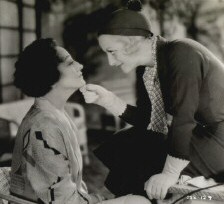 This
Modern Age. MGM, 1931. Directed by Nicholas Grinde, 68 minutes. A blonde
Joan stars
as free-spirited daughter "Valentine Winters,"
who's reunited in Paris with her divorced mother (Pauline Frederick)
and is courted by the stuffy Neil Hamilton, who disapproves of Valentine's wild
ways and family.
This
Modern Age. MGM, 1931. Directed by Nicholas Grinde, 68 minutes. A blonde
Joan stars
as free-spirited daughter "Valentine Winters,"
who's reunited in Paris with her divorced mother (Pauline Frederick)
and is courted by the stuffy Neil Hamilton, who disapproves of Valentine's wild
ways and family.
Says Joan in CWJC: Forget This Modern Age.
Says Joan in Portrait of Joan: It was hopelessly artificial, especially for a depression year. Critics called it "a shop girl's delight" and said, "Pretty thin ice for a release to be skating on this season." It would be my first starrer that failed to hit big grosses and it wasn't my fault, they said. I deserved something less ridiculous in the way of a story, they said. They were right about the story, wrong about the grosses. There must have been a lot of shop girls, bless 'em.
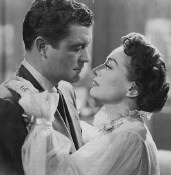 This
Woman Is Dangerous. Warners, 1952. Directed by Felix Feist, 97 minutes.
Joan stars as gangstress "Beth Austin,"
who needs an eye operation and falls in love with the doctor. Co-starring Dennis Morgan
(doctor) and David Brian (gangsta). Banned in Finland! This
was Joan's last picture under contract to Warners, and one she said in 1973
was her very worst. Says Joan in CWJC:
This
Woman Is Dangerous. Warners, 1952. Directed by Felix Feist, 97 minutes.
Joan stars as gangstress "Beth Austin,"
who needs an eye operation and falls in love with the doctor. Co-starring Dennis Morgan
(doctor) and David Brian (gangsta). Banned in Finland! This
was Joan's last picture under contract to Warners, and one she said in 1973
was her very worst. Says Joan in CWJC:
I must have been awfully hungry. I guess I was. Kids in schools, the house... nothing was right about This Woman Is Dangerous. A shoddy story, a cliche script, no direction to speak of. The thing just blundered along. I suppose I could have made it better, but it was one of those times when I was so disgusted with everything I just shrugged and went along with it. That is unforgivable, isn't it?
Thomas, Bob. Longtime AP reporter (he got the now-famous quotes from Joan about Marilyn Monroe after Monroe's appearance at the 1953 Photoplay Awards), and author of the first, and still solid, Joan bio (Joan Crawford: A Biography, 1978).
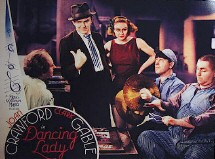 Three Stooges,
The. Yes, nyuk-nyuk-nyuk, Joan did a picture with them! 1933's Dancing
Lady, where they were billed
as "Ted Healy and His Stooges" and gave Joan's character a hard time
while she was trying to rehearse.
Three Stooges,
The. Yes, nyuk-nyuk-nyuk, Joan did a picture with them! 1933's Dancing
Lady, where they were billed
as "Ted Healy and His Stooges" and gave Joan's character a hard time
while she was trying to rehearse.
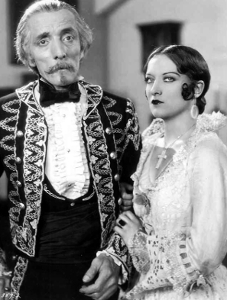 Tide
of Empire. Released 3/23/29, this film ultimately starred
Renee Adoree as "Josephita." According to various sources,
though, the film initially featured Joan in this role. From
TCM.com:
Tide
of Empire. Released 3/23/29, this film ultimately starred
Renee Adoree as "Josephita." According to various sources,
though, the film initially featured Joan in this role. From
TCM.com:
Originally, the part of Josephita was to be played by rising star Joan
Crawford. A series of costume and makeup tests were photographed in
preparation for filming. But, upon the success of 1928's Our Dancing Daughters, she was taken off Tide and steered toward roles that would cultivate her persona of a Jazz Age flapper (such as Our Modern Maidens, 1929). The role of Don José's daughter went instead to Renée Adorée (The Big Parade, 1925), who had frequently played rustic beauties (though usually of French extraction).
1928
publicity shots featuring Joan
(this site)
(Thanks to Tom C. for sharing his info
and links.)
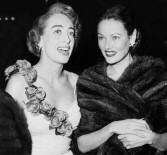 Tierney,
Gene. (11/19/20 - 11/6/91) U.S. actress. One of the nominees for Best Actress
of 1945 (which Joan won for Mildred Pierce) for Leave Her
to Heaven.
Tierney,
Gene. (11/19/20 - 11/6/91) U.S. actress. One of the nominees for Best Actress
of 1945 (which Joan won for Mildred Pierce) for Leave Her
to Heaven.
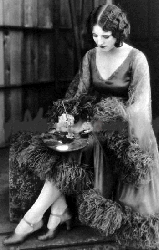 Time,
the Comedian. Joan appears as an uncredited extra ("art
student") in this 1925 MGM film (NYC release: 12/13/25) directed
by Robert Z. Leonard and starring Mae Bush.
Time,
the Comedian. Joan appears as an uncredited extra ("art
student") in this 1925 MGM film (NYC release: 12/13/25) directed
by Robert Z. Leonard and starring Mae Bush.
• To learn more about the film in general, see the AFI page. To see Joan's credit (as Lucille LeSueur) and also to learn more, see the IMDb page.
• You can also visit the Lantern Media History Digital Library site to see a photo of Joan from the Exhibitor's Trade Review (May-Aug 1925) with the caption: "Lucille LeSueur signs the palate she used in Metro's Time, the Comedian." (This same photo---pictured at left---currently appears in this site's The Boob photo section; Joan was shooting her credited appearance in The Boob at the same time she was publicizing Time.)
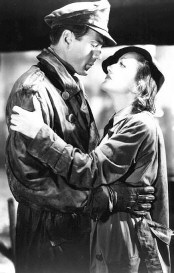 Today
We Live. MGM, 1933. Directed by Howard Hawks, 115 minutes. Joan stars as
"Diana Boyce-Smith," a
young, wealthy, playgirl Englishwoman during WWI. (This is her first film with future
husband Franchot Tone, whom she would marry in 1935; her only film with Gary
Cooper; and her first of three films with Robert Young.) The
film was based on a story by William Faulkner that didn't include any women,
so a few changes had to be made! Says Joan in CWJC: ...I
was extremely uncomfortable with a British accent in Today We Live.
But when a lady is directed by Howard Hawks and has Gary Cooper, Robert Young,
and Franchot Tone to set her off she can't complain too much.
Today
We Live. MGM, 1933. Directed by Howard Hawks, 115 minutes. Joan stars as
"Diana Boyce-Smith," a
young, wealthy, playgirl Englishwoman during WWI. (This is her first film with future
husband Franchot Tone, whom she would marry in 1935; her only film with Gary
Cooper; and her first of three films with Robert Young.) The
film was based on a story by William Faulkner that didn't include any women,
so a few changes had to be made! Says Joan in CWJC: ...I
was extremely uncomfortable with a British accent in Today We Live.
But when a lady is directed by Howard Hawks and has Gary Cooper, Robert Young,
and Franchot Tone to set her off she can't complain too much.
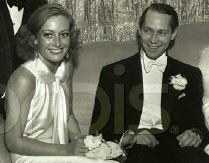 Tone, Franchot.
(2/27/05 - 9/18/68) U.S. actor, Joan's second husband
(married October 11, 1935; divorced April 11, 1939). Full name: Stanislas Pascal
Franchot Tone. Tone came from a wealthy family (his father was president of
the Carborundum Company), and was an original member of New York's renowned
Group Theater. He came to Hollywood in 1932 with the intention of making quick
money in pictures that he could use to finance Group Theater work; instead
he met Joan Crawford and stayed on. He received a 1935 Academy
Award nomination as Best Actor for his role in Mutiny on the Bounty.
He was married 4 times: after Joan, to Jean Wallace (1941-1948, two sons); Barbara
Payton (1951-1952); and Dolores Dorn (1956-1959).
Tone, Franchot.
(2/27/05 - 9/18/68) U.S. actor, Joan's second husband
(married October 11, 1935; divorced April 11, 1939). Full name: Stanislas Pascal
Franchot Tone. Tone came from a wealthy family (his father was president of
the Carborundum Company), and was an original member of New York's renowned
Group Theater. He came to Hollywood in 1932 with the intention of making quick
money in pictures that he could use to finance Group Theater work; instead
he met Joan Crawford and stayed on. He received a 1935 Academy
Award nomination as Best Actor for his role in Mutiny on the Bounty.
He was married 4 times: after Joan, to Jean Wallace (1941-1948, two sons); Barbara
Payton (1951-1952); and Dolores Dorn (1956-1959).
Though he reportedly was physically abusive to Joan while married, they remained close until his death (she was the one who had his ashes scattered). Said Joan in CWJC:
Franchot was an extremely loving, intelligent, considerate man, but he was also very haunted. He was one hell of a fine actor, but he loved the theatre and despised Hollywood. He very seldom got the parts he deserved, and I think this bugged him a lot. I wasn't as nice to him, as considerate, as I should have been. I was extremely busy during those years, and I didn't realize that his insecurities and dissatisfactions ran so deeply. His sex life diminished considerably, which didn't help matters, and there finally came a time when we only had things to argue about, not to talk about, and after hundreds of running arguments and a few physical rows we decided to call it quits. I missed him a lot, for a long, long time. He was so mature and stimulating. I think I can safely say that the break-up was another career casualty. If I'd tried a little harder--who knows.
After their marriage, Tone had this to say: "She's like that old joke about Philadelphia. First prize, four years with Joan, second prize, eight."
The two made 7 films together (he was her third most frequent co-star after Gwen Lee and Gable): Today We Live ('33), Dancing Lady ('33), Sadie McKee ('34), No More Ladies ('35), The Gorgeous Hussy ('36), Love on the Run ('36), and The Bride Wore Red ('37).
Tonight. NBC late-night talk show. Joan first appeared there (9/29/54) when Steve Allen was host, then later was a guest on Johnny Carson's debut show (10/2/62), and appeared with Carson at least twice more (2/16/65 and 5/14/65).
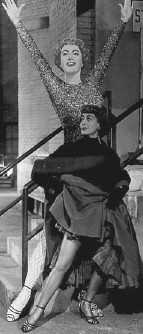 Torch
Song. MGM, 1953. Directed by Charles Walters, 90 minutes. Joan's return
to MGM after 10 years, and her first appearance in Technicolor. She plays musical
star "Jenny Stewart" and performs a blackface number, among other
of the film's oddities, which include a party Jenny throws with the only guests
being men in blue suits. Also starring Michael Wilding (then married to Liz Taylor), Gig Young,
and Marjorie Rambeau (who received an Oscar nomination as Jenny's down-to-earth
ma). Says Joan in CWJC:
Torch
Song. MGM, 1953. Directed by Charles Walters, 90 minutes. Joan's return
to MGM after 10 years, and her first appearance in Technicolor. She plays musical
star "Jenny Stewart" and performs a blackface number, among other
of the film's oddities, which include a party Jenny throws with the only guests
being men in blue suits. Also starring Michael Wilding (then married to Liz Taylor), Gig Young,
and Marjorie Rambeau (who received an Oscar nomination as Jenny's down-to-earth
ma). Says Joan in CWJC:
My God, back at Metro, after all those years...it was like a homecoming, and half the people on the set, the prop men and the grips...they remembered me and I remembered them. I loved doing that film. It gave me a chance to dance again, to pretend to sing, to emote all over the place, and in color, yet! If I hadn't brought it off I'd have only myself to blame because all the right elements were there. It was a field day for an actress, particularly one who'd reached a certain age. They don't write pictures like this anymore, do they?

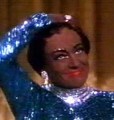
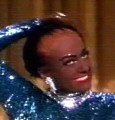
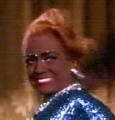
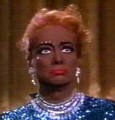
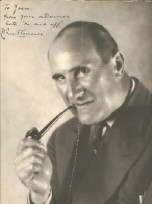 Torrence,
Ernest. (6/26/1878 - 5/15/33) Scottish-born actor who debuted on film
in 1919. Joan's co-star in 1927's Twelve
Miles Out,
'28's
Across
to Singapore,
and '29's Untamed. Says
Joan in EB: "He was nothing like his bad-tempered, horrible screen image.
He was a very sweet, good-natured man, generous, loving, and helpful."
Torrence,
Ernest. (6/26/1878 - 5/15/33) Scottish-born actor who debuted on film
in 1919. Joan's co-star in 1927's Twelve
Miles Out,
'28's
Across
to Singapore,
and '29's Untamed. Says
Joan in EB: "He was nothing like his bad-tempered, horrible screen image.
He was a very sweet, good-natured man, generous, loving, and helpful."
(The picture at left is autographed to Joan: "from your admirer both 'on and off.'") IMDb info.
Town Hall. Historic NYC venue (West 43rd Street between 6th Avenue and Broadway) where Joan appeared on 4/8/73 as part of the "Legendary Ladies of the Movies" series hosted by John Springer. Click here to read a transcript of the event. And here to see photos of Joan at her event.
The 1,500-seat performance space opened in 1921, commissioned by the League for Political Education as an egalitarian ("not a bad seat in the house") forum for discussing political and social issues. It has since also established a reputation as a premiere arts venue. Town Hall was designated a National Historic Landmark in 2013.
Official website. Wikipedia page.
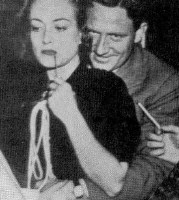 Tracy,
Spencer. (4/5/1900 - 6/10/1967)
Tracy,
Spencer. (4/5/1900 - 6/10/1967)
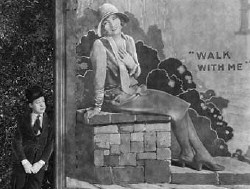 Tramp,
Tramp, Tramp. First National silent, 1926, starring comedian Harry Langdon. Directed
by Harry Edwards, 62 minutes. Joan plays "Betty
Burton," Langdon's love interest.
Tramp,
Tramp, Tramp. First National silent, 1926, starring comedian Harry Langdon. Directed
by Harry Edwards, 62 minutes. Joan plays "Betty
Burton," Langdon's love interest.
Said Joan in CWJC: ... a wistful comedy but the picture belonged to Harry Langdon.
Said Joan in JC: The Essential Biography: [I was] playing not second fiddle, not third fiddle, but more like fifth fiddle to Harry's comic stunts!
For Joan's memories of working with Harry Langdon on this film, see the Langdon entry.
Travilla, William. (3/22/20 – 11/02/90) American costume designer for film, TV, and theater, perhaps best known for dressing Marilyn Monroe in eight of her films. He worked with Joan on one film, Flamingo Road, a collaboration that wasn't completely pleasant (although she was to do him a favor years later). Eric Woodard, quoting Hollywood Costume Design by Travilla by Maureen Reilly, writes on his "Travilla Style: Fifty Years of Film and Fashion" blog (12/30/14):
"Some people, no matter how hard you try, just can't be satisfied" Travilla stated. "Joan was playing a poor carnival dancer, and her first test shots were in close-up only. So I loaned her a sweater, just something I had in stock that I thought might work for that sequence. I also loaned her a skirt, that wouldn't even show in the test." The next day, Travilla was fitting another actress when "I got a call from the assistant director asking me to come to the set. 'Miss Crawford doesn't like the skirt.' I said I couldn't come and carried on with the fitting." Crawford went into a furious rage and walked from the soundstage to Travilla's office where "she slammed the door open so hard the knob went clean through the wall and stuck fast."
Taking no account that another actress was there, "Joan exploded! And her tirade included more four-letter words that I'd ever heard from a woman before. Later in the day, a beautiful bouquet of flowers arrived for me with a sincere note of apology." But Travilla found Crawford so difficult that "I was happy to loan her my patterns, but wouldn't make or fit the clothes myself."
Almost a decade later, after Travilla had left the studio system and began his private label line, Crawford proved what a lady she could be. "I was showing my collection at the Plaza Hotel in New York City and Joan came to see my clothes. She was a vision in brilliant green, with a silk print dress and matching turban. Even her gloves, bag and shoes were dyed the same shade of emerald." As his models were showing the collection, "The head buyer of a store very important to me arrived. They joined us and of course, wanted to meet the great Joan
Crawford!" Travilla remembers, "when the show began to repeat itself, Joan stood up to leave and put on her green silk coat, lined in the same print as her dress. She shook hands all around and said:' I'll give you a call about the clothes I want, Billy. I took down all the numbers.' I'll never forget it; that was a lovely thing for her to say in front of the buyers."

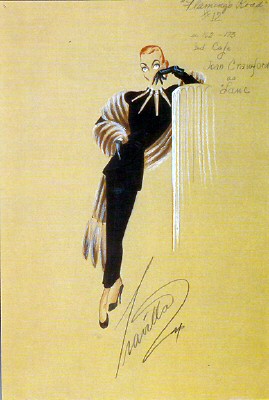
Wikipedia page. Official website.
 Trog.
Warners, 1970. Directed by Freddie Francis and produced by Herman
Cohen, 93 minutes. In her last picture,
Joan plays "Dr. Brockton,"
a scientist hoping to rehabilitate a rampaging Missing Link. The budget
for the film was so low that Joan used a car for a dressing room and provided
her own wardrobe (aside from the lab coat). Says Joan in CWJC: If
I weren't a Christian Scientist, and I saw Trog advertised on a
marquee across the street, I think I'd contemplate suicide.
Trog.
Warners, 1970. Directed by Freddie Francis and produced by Herman
Cohen, 93 minutes. In her last picture,
Joan plays "Dr. Brockton,"
a scientist hoping to rehabilitate a rampaging Missing Link. The budget
for the film was so low that Joan used a car for a dressing room and provided
her own wardrobe (aside from the lab coat). Says Joan in CWJC: If
I weren't a Christian Scientist, and I saw Trog advertised on a
marquee across the street, I think I'd contemplate suicide.
Truffaut, Francois. (2/6/32 - 10/21/84) IMDb info.
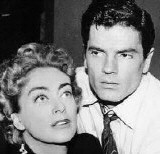 Tryon,
Tom. (1/14/26 - 9/4/91) Actor in films and TV from '55 through
'69 who co-starred with Joan in a 1958 episode of GE
Theater:
"Strange Witness." Tryon later went on to write novels
such as Harvest Home (1973, made into a TV mini-series with
Bette Davis in 1978) and All That Glitters (1986, which contained,
according to the Quirk/Schoell Joan bio, a character based on Joan
named "Claire Regrett").
Tryon,
Tom. (1/14/26 - 9/4/91) Actor in films and TV from '55 through
'69 who co-starred with Joan in a 1958 episode of GE
Theater:
"Strange Witness." Tryon later went on to write novels
such as Harvest Home (1973, made into a TV mini-series with
Bette Davis in 1978) and All That Glitters (1986, which contained,
according to the Quirk/Schoell Joan bio, a character based on Joan
named "Claire Regrett").
 Turner,
Lana. (2/8/21 - 6/29/95) Turner made her MGM debut in 1937, and by 1939
was part of the crop of up-and-comers threatening to dethrone reigning movie
queens such as Joan. (See the Middle
Years
entry.) To add insult to injury, Turner also began dating a Joan paramour, lawyer
Greg
Bautzer,
around this time. Wrote Turner in her autobiography Lana: The Lady, the Legend,
the Truth (Dutton, 1982):
Turner,
Lana. (2/8/21 - 6/29/95) Turner made her MGM debut in 1937, and by 1939
was part of the crop of up-and-comers threatening to dethrone reigning movie
queens such as Joan. (See the Middle
Years
entry.) To add insult to injury, Turner also began dating a Joan paramour, lawyer
Greg
Bautzer,
around this time. Wrote Turner in her autobiography Lana: The Lady, the Legend,
the Truth (Dutton, 1982):
... My billing went up a notch after Calling
Dr. Kildare, so for my next picture, These Glamour Girls, I had more
publicity chores. That meant I’d have to be home by
midnight.
Greg [Bautzer]
accepted my time limitations. He’d
drop me off, say good night, and kiss me good-bye. What I was too young and
inexperienced to realize was that Greg was getting his action on the
side….
One day I got a phone call from Joan
Crawford. Greg had taken me to several parties at her house, but I didn’t know
her well. Those parties were all the same. After dinner the guests would be
herded into a projection room to watch movies. Joan knitted constantly. During
the film you could always hear her needles clicking away.
I was surprised and intrigued by her
call, but even more by her request. “Lana, dear,” she cooed, “I wonder if you’d
drive out to my home. I’d like to talk to you about something very
important.”
When I arrived she greeted me cordially
and fussed over making me comfortable. “Now, darling,” she began, “you know I’m
a bit older than you, and so I may know some things you haven’t learned
yet...”
“Like what?” I asked, thinking that she
was quite a bit older.
“Well, dear, when you’re young you see
things a certain way, but that’s not always how they are. As you get older you
realize that life can be very complex…” She continued rambling, as I grew more
and more fidgety.
Finally I interrupted her. “Joan, what
are you trying to tell me?”
Looking back, I sometimes marvel at the
acting performance Joan delivered there in her living room. Sincerity overcame
her. Her hand went to her forehead, then to her heart. Agitatedly, she reached
for a cigarette, then fumbled with the matches. Finally she got it lit and drew
in deeply, gearing herself for the thrust.
What a thrust! “Well, darling, I feel it’s only right to tell you that Greg doesn’t love you anymore… that he hasn’t for a long time.... I couldn’t let you go on, hoping, believing… Because, you see, Greg wouldn’t tell you. Darling, you’ve simply got to know that what Greg and I have is real, and it’s been going on for a long time. It’s me he truly loves…” She gave me a direct look, and her eyes hardened. “But he hasn’t figured out how to get rid of you.”...
My head was whirling. Was she telling the truth? Maybe I’d suspected Greg was seeing other women – but Joan? Was I crazy or was she? ...
Bautzer tried to placate Turner when confronted, but she rebounded by eloping with bandleader Artie Shaw months later, in early 1940. Bautzer and Joan would date off and on for another 10 years or so.
TV. (See also the Joan TV page.)
In an April 14, 1954, letter to friend Asher Hayes, Joan wrote: "I'm making the awful decision to do or not do television and if I do it, I'll be off the screen two years before I can get another film out. It's kind of a rugged thing. A picture would give me immediate salary, television would give me no salary for a year and a half but, an annuity in the long run."
Aside from the various appearances in the medium that she ended up making, Joan was also a fan according to JCB. Some of her favorite programs included many daytime serials, Walter Cronkite, Bonanza, and The Waltons. But in CWJC she also says:
Sometimes I wonder if TV, with all its incessant bombardment of images, hasn't shriveled our imagination... The biggest mystery to me is why people watch the pictures made for television... The cheapest film produced on Metro's back lot was better than any produced-for-television film I've seen so far.... If MGM and Warners etc. had become real TV producers at the beginning they could have dominated the field and used TV as a branch of the studio operation. But they didn't. They tried to compete with it, which they couldn't, and they tried to ignore it, which they couldn't. By the time they were active in production it was too late; bright, young new companies were dominating network time. And some very smart actors and actresses swallowed their pride...and moved from movies to TV.
TWA. Click here to see a 1961 ad Joan did for the airline.
 Twelve
Miles Out. MGM silent, 1927, starring John Gilbert. Directed by Jack Conway,
85 minutes. Joan plays "Jane," who's kidnapped by bootlegger Gilbert
and eventually falls in love with him. Says Joan in CWJC: ... the first time that magic man-woman chemistry happened in
one of my films: John Gilbert and I seemed to exude sex. (He was having an affair
with Garbo at the time, so nothing came of it personally, but on-screen -- wow!)
Twelve
Miles Out. MGM silent, 1927, starring John Gilbert. Directed by Jack Conway,
85 minutes. Joan plays "Jane," who's kidnapped by bootlegger Gilbert
and eventually falls in love with him. Says Joan in CWJC: ... the first time that magic man-woman chemistry happened in
one of my films: John Gilbert and I seemed to exude sex. (He was having an affair
with Garbo at the time, so nothing came of it personally, but on-screen -- wow!)
